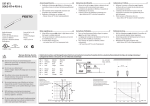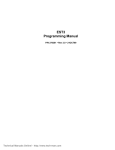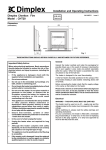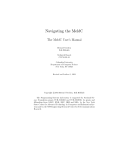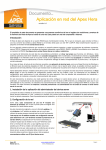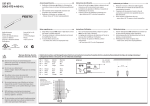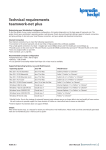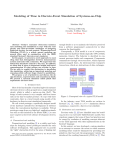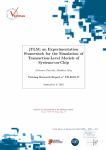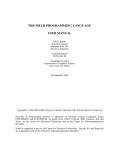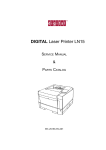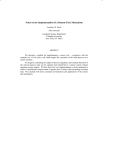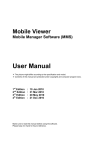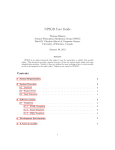Download Part 6 - School of Computer Science Student WWW Server
Transcript
Documentation Requirements
CS452/652
Real-Time
Programming
Course Notes
For the Kernel Assignment:
g
Description of all major components of the system,
e.g. memory management, task management,
context switching. Context switching should be
described in detail.
g
Description of kernel data structures and
algorithms, e.g., task descriptors, scheduler, etc.
g
Description of syscall implementation, including
parameter passing.
Daniel M. Berry, Cheriton School of Computer Science
University of Waterloo
2007 Daniel M. Berry
Real-Time Programming: Trains Pg. 1
Doc. Reqs., Cont’d
g
2007 Daniel M. Berry
Real-Time Programming: Trains Pg. 2
Hardware Interrupts
Explain why your implementation meets real-time
requirements, by giving the complexity of each
kernel operation.
g
Description of test cases, including that they cover
what should be tested.
g
User’s manual
g
Tour of source code.
USART1
7
6
5
4
3
2
1
0
USART0
ICU1
8259
ICU0
8259
INT
CPU
0
RTC
PIT
BUS
2007 Daniel M. Berry
Real-Time Programming: Trains Pg. 3
2007 Daniel M. Berry
Real-Time Programming: Trains Pg. 4
Acronyms
How A Device Speaks to CPU
USART = Universal Synchronous Asynchronous
Receiver/Transmitter
1. External event occurs.
ICU = Interrupt Control Unit
3. Interrupts are priority ranked by the ICU, which
interrupts the CPU.
RTC = Real Time Clock
2. Device asserting interrupt asserts its interrupt line.
4. CPU reads IRQ (interrupt request) level from ICU
data bus.
PIT = Programmable Interval Timer
5. CPU begins interrupt processing.
It bothers me that RTC and PIT are different, because
of the chances for drift.
2007 Daniel M. Berry
Real-Time Programming: Trains Pg. 5
Interrupt Numbers
2007 Daniel M. Berry
Real-Time Programming: Trains Pg. 6
To Make Interrupts Happen
Processor Internal (GPF, division by zero,
g
Enable Interrupts by setting IF (Interrupt Enable
Flag), which is stored in EFLAGS register.
31–39
First ICU (IRQ0–IRQ7)
g
40–47
Second ICU (IRQ8–IRQ15)
Instructions are:
STI — set IF (enable)
CLI — clear IF (disable)
0–31
etc.)
48–255 Software Interrupts; ∴, for int n, be sure
that n≥48!
2007 Daniel M. Berry
Real-Time Programming: Trains Pg. 7
2007 Daniel M. Berry
Real-Time Programming: Trains Pg. 8
Happening, Cont’d
g
CPU’s response to an Interrupt
Interrupts are:
f
enabled in non-kernel tasks,
f
disabled in the kernel, and
f
enabled at boot up.
1. Push EFLAGS, including current IF.
2. Clear IF and TF (trap flag, to enable singlestepping; in single-step mode, each instruction is an
interrupt).
g
Unmask interrupts of interest in ICUs.
g
Configure each device to generate interrupts.
3. Push CS
4. Push EIP
5. Load CS, EIP from IDT.
2007 Daniel M. Berry
Real-Time Programming: Trains Pg. 9
2007 Daniel M. Berry
Real-Time Programming: Trains Pg. 10
Interrupt Service Routine
Event Abstraction
1. Record interrupt number.
An event abstraction is the representation of an
external event at the task level.
2. Switch into kernel.
3. Send non-specific EOI to ICUs, otherwise they
won’t generate any more interrupts:
g
More than one event can be associated with a
physical device, e.g., as for serial input and output.
g
int AwaitEvent(int EventNumber) — block and
wait for an instance of the specified event to occur.
g
Event may occur before int AwaitEvent is issued;
therefore buffer at least one instance of each kind of
event.
outb(IO_ICU1,0x20)
outb(IO_ICU2,0x20)
2007 Daniel M. Berry
Real-Time Programming: Trains Pg. 11
2007 Daniel M. Berry
Real-Time Programming: Trains Pg. 12
Event Abstraction, Cont’d
A Possible Application of Events
g
Associate an event number with each hardware
event.
g
Can have also software events.
g
int SignalEvent(int EventNumber) — signals an
instance of the specified event, unblocking a task
that is awaiting that event number.
2007 Daniel M. Berry
Block a task until the fulfillment of a condition, but
allow more than one task to fulfill the condition and
then unblock the the waiting task.
Real-Time Programming: Trains Pg. 13
Server Implementation
2007 Daniel M. Berry
Real-Time Programming: Trains Pg. 14
Server Implementation, Cont’d
g
Client
1
g
On Receive(), server is RECEIVE_BLOCKED
On AwaitEvent(), server is EVENT_BLOCKED
Cannot service clients while EVENT_BLOCKED.
Server
Receive()
HW
AwaitEvent()
.
.
.
Client
N
2007 Daniel M. Berry
Real-Time Programming: Trains Pg. 15
Cannot respond to events while
RECEIVE_BLOCKED.
∴, one type of event starves the other.
How can we prevent this starvation?
2007 Daniel M. Berry
Real-Time Programming: Trains Pg. 16
Event Notifier Task
Notifier
Client
1
.
Notifier
Server
.
.
External
Event
2007 Daniel M. Berry
Client
N
Real-Time Programming: Trains Pg. 17
Server
Then server needs to call only Receive(), and not
AwaitEvent().
Notifier and clients are then serviced in the order in
which they send.
2007 Daniel M. Berry
Real-Time Programming: Trains Pg. 18
Implementation
Server(){
Initialize(); CreateNotifier(); RegisterAs(…);
while(1){
(tid,msg) ← Receive();
if (tid==Notifier){
Reply(Notifier,NULL);
serviceDevice();
} else {
serviceRequest();
}
}
}
2007 Daniel M. Berry
Notifier(){
while(1){
AwaitEvent(eventNumber); /* transform event to */
Send(Server,eventNumber,NULL); /* a message */
}
}
Real-Time Programming: Trains Pg. 19
New state: EVENT_BLOCKED
Event table:
g
indexed by event numbers
g
buffers event information
g
records waiting tasks if any
2007 Daniel M. Berry
Real-Time Programming: Trains Pg. 20
Clock Server
Delay
Delay(int t):
Delay(int t){
int clock = WhoIs("clockServer");
Send(clock,(char *)&t,sizeof(t),NULL,0);
}
g
Blocks caller for at least t ticks.
g
A tick is 1/20 of a second.
g
Implemented by sending a message to clock server.
g
Clock server replies after at least t ticks.
2007 Daniel M. Berry
Real-Time Programming: Trains Pg. 21
Clock Server
2007 Daniel M. Berry
Real-Time Programming: Trains Pg. 22
A Problem
Client
1
What if ALL tasks, other than the clock server and
notifier, call Delay()?
What happens between now and the next clock tick?
.
Notifier
Clock
Server
.
.
Clock
Event
2007 Daniel M. Berry
Client
N
Real-Time Programming: Trains Pg. 23
2007 Daniel M. Berry
Real-Time Programming: Trains Pg. 24
What Happens if All Delay?
g
Kernel has no tasks to run.
g
Kernel cannot wait for a hardware event to wake up
a notifier,
Create an idle task that never blocks, and runs at the
lowest priority!
because interrupts are disabled!
∴ There needs to be a running task.
2007 Daniel M. Berry
Always Running Task
Real-Time Programming: Trains Pg. 25
IdleTask(){
while(1);
}
2007 Daniel M. Berry
Real-Time Programming: Trains Pg. 26
Clock Server
Loop Body
ClockServer(){
time = 0;
InitializePIT();
notifier = CreateClockNotifier();
while(1){
Loop Body
}
}
(pid,request) ← Receive();
if(pid == NOTIFIER){
time++;
Reply(pid,NULL);
while(nextWaitingTime() <= time){
pid = dequeueWaitingTask();
Reply(pid,NULL);
}
} else { /* assuming that only request is Delay */
enqueueWaitingTask(pid,time + timeRequest);
}
2007 Daniel M. Berry
Real-Time Programming: Trains Pg. 27
2007 Daniel M. Berry
Real-Time Programming: Trains Pg. 28
Loop Body, Cont’d
Clock Notifier
This body assumes that there is only one kind of
request, i.e., Delay.
ClockNotifier(){
while(1){
AwaitEvent(PIT_EVENT);
Send(MyParentPid(),NULL,NULL);
}
}
If there are others, the else part will have to have a
case to separate out which request it is.
2007 Daniel M. Berry
Real-Time Programming: Trains Pg. 29
2007 Daniel M. Berry
Real-Time Programming: Trains Pg. 30
Programmable Interval Timer
Mode ?
The programmable interval timer (PIT), the Intel 8253:
Mode 1 = HW Interrupt or Exception in Virtual 8086
Mode
g
Interrupt number 32
g
Counter 0
Mode 2 = Maskable HW Interrupt in Virtual 8086
Mode
g
Mode 2
Mode 3 = SW Interrupt in Virtual 8086 Mode
For interrupt number and counter, see Diagram on Page
4.
2007 Daniel M. Berry
Real-Time Programming: Trains Pg. 31
2007 Daniel M. Berry
Real-Time Programming: Trains Pg. 32
More Clock Primitives
Delay vs DelayUntil
int getTime() — returns the current tick count
while (1){
Delay(x);
doSomething();
}
DelayUntil(int t) — delay until a specified time t; the
executing process is blocked to be awakened when tick
count ≥ t.
t = getTime();
while (1){
t+=x; DelayUntil(t);
doSomething();
}
These are optional in your kernel.
2007 Daniel M. Berry
should have the same effect as
Real-Time Programming: Trains Pg. 33
2007 Daniel M. Berry
Real-Time Programming: Trains Pg. 34
Delay vs DelayUntil, Cont’d
One Real Difference
but they don’t.
The doSomething takes time.
What’s the REAL Difference?
∴, the period in the first case is x + time
(doSomething),
and the period in the second case is x.
2007 Daniel M. Berry
Real-Time Programming: Trains Pg. 35
2007 Daniel M. Berry
Real-Time Programming: Trains Pg. 36
Another Real Difference
Scheduling Options
Amount of delay ≥ x, say x+ε.
time-slicing
fair
These εs accumulate under successive Delays, but …
vs.
run-to-completion
efficient
These εs do not accumulate under successive
DelayUntils.
∴, DelayUntil enforces stricter periodicity.
2007 Daniel M. Berry
Real-Time Programming: Trains Pg. 37
2007 Daniel M. Berry
Real-Time Programming: Trains Pg. 38
When to Reschedule
Serial Chip
Rescheduling when a task calls the kernel!
Serial Chip, PC16550D, Universal Asynchronous
Receiver/Transmitter (UART) (See Documentation
from byterunner)
Pass() must reschedule!
Should interrupt currently executing task periodically,
e.g., every k ticks, to force rescheduling for roundrobin purposes?
Registers:
Transmit Holding Register — for reading from the
serial port
Preemption required when a task of a priority higher
than that of the running task becomes READY due to
an external event!
2007 Daniel M. Berry
Real-Time Programming: Trains Pg. 39
Receiver Buffer Register — for writing to the serial
port
2007 Daniel M. Berry
Real-Time Programming: Trains Pg. 40
Registers, Cont’d
Registers, Cont’d
Interrupt Enable Register — for enabling and
disabling interrupts
Line Control Register — to initialize the chip with
parity, stop bits, etc.
Interrupt Types:
g
Received Data Available
g
Transmit Holding Register Empty
g
Receiver Line Status — for error conditions
g
Modem Status — not needed
Line Status Register — diagnostics, e.g., ready,
error conditions, etc.
Interrupt Identification Register — to determine
what kind of interrupt fired
2007 Daniel M. Berry
Real-Time Programming: Trains Pg. 41
2007 Daniel M. Berry
Real-Time Programming: Trains Pg. 42
Primitives for Kernel Part III
Kernel Part III, Cont’d
ClockServer
required
Delay(int t)
optional
int GetTime()
DelayUntil(int t)
SerialServer
required
byte=GetPort(port)
Put(byte,port)
optional
write(port,buffer,length) — atomically
read(port,buffer,length)
readLine(port,buffer,length)
See Complete I/O Port List.
2007 Daniel M. Berry
Real-Time Programming: Trains Pg. 43
2007 Daniel M. Berry
Real-Time Programming: Trains Pg. 44
Serial Server
Serial Server, Cont’d
Like the producer–consumer problem, but with
multiple producers and multiple consumers.
Reader
1
.
.
.
Notifier
1
Reader
M
.
.
Serial
Server
UART
.
Writer
1
Notifier
K
.
.
.
One notifier per port
Writer
N
2007 Daniel M. Berry
Real-Time Programming: Trains Pg. 45
What If?
2007 Daniel M. Berry
Real-Time Programming: Trains Pg. 46
Too Many Readers
Too many readers or writers or both could starve the
notifier, …
Writer
1
Writer
2
and the notifier could miss interrupts.
Notifier
Writer
3
.
.
.
.
.
.
Serial
Server
Serial
events
How can we ensure that the notifier does not miss
interrupts and answers them on time?
Writer
100000000
2007 Daniel M. Berry
Real-Time Programming: Trains Pg. 47
2007 Daniel M. Berry
Real-Time Programming: Trains Pg. 48
Guard Process
Guard
Reader
1
.
.
.
Reader
M
Reader
Guard
Notifier
Serial
Server
Writer
1
.
.
.
Serial
events
Writer
Guard
Should there be a delay guard for the clock server?
Writer
N
2007 Daniel M. Berry
Guard(){
serialServer = MyParentPid();
while(1){
(tid,msg) ← Receive();
replyMsg ← Send(serialServer,msg);
Reply(tid,replyMsg);
}
}
Real-Time Programming: Trains Pg. 49













